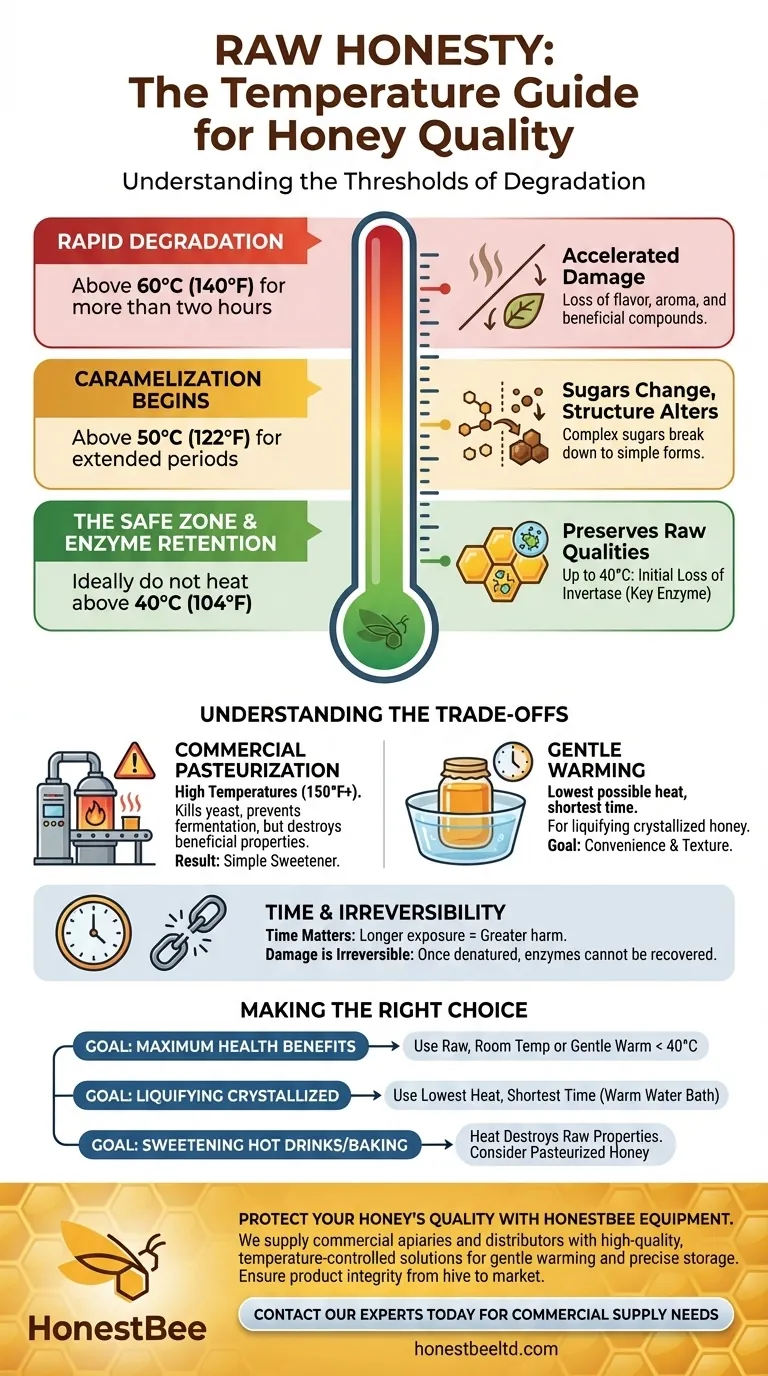To preserve its raw qualities, honey should ideally not be heated above 40°C (104°F). Exceeding this temperature begins to destroy valuable enzymes. As the temperature increases further, the degradation becomes more rapid and severe, fundamentally altering the honey's chemical structure and nutritional value.
The core issue isn't a single "do not exceed" temperature, but a spectrum of degradation. Any heat application risks diminishing the unique properties of raw honey, with the damage increasing significantly with both higher temperatures and longer exposure times.

The Critical Temperature Thresholds for Raw Honey
Heating raw honey is a process of diminishing returns. Each temperature milestone removes more of the beneficial components that define it as "raw."
The Initial Loss of Enzymes (Up to 40°C / 104°F)
The most immediate and sensitive components to suffer from heat are the enzymes.
Heating honey up to 40°C (104°F) destroys invertase, a key enzyme. This enzyme helps break down complex sugars and contributes to the unique antibacterial properties of raw honey. This is the first threshold where raw honey begins to lose its distinct biological activity.
The Start of Caramelization (Above 50°C / 122°F)
Beyond enzyme loss, the very nature of the honey's sugars begins to change.
Heating honey to 50°C (122°F) for an extended period, such as 48 hours, will initiate caramelization. During this process, the valuable and complex sugars in honey break down, transforming its structure into something more analogous to simple sugar.
The Point of Rapid Degradation (Above 60°C / 140°F)
At higher temperatures, the damage accelerates dramatically.
Heating honey above 60°C (140°F) for more than two hours will cause rapid degradation of its quality. At this stage, you lose not only enzymes but also flavor subtleties, aromas, and other beneficial compounds, leaving little more than a simple sweetener.
Understanding the Trade-offs
Most commercial, non-raw honey is pasteurized at very high temperatures (often 150°F or higher) to kill yeast, prevent fermentation, and keep it liquid for longer. This process destroys all the beneficial properties that make raw honey desirable.
The Goal of Gentle Warming
The primary reason to gently warm raw honey is to return it to a liquid state after it has naturally crystallized. This is purely for convenience and texture.
The Irreversible Damage
It's critical to understand that the damage from heat is irreversible. Once an enzyme like invertase is denatured, it cannot be recovered.
The Role of Time
Time is as crucial a factor as temperature. A brief warming to 35°C (95°F) is significantly less damaging than holding honey at that same temperature for many hours. The longer the exposure, the greater the harm.
Making the Right Choice for Your Goal
Your approach to heating honey should be dictated by your primary goal for using it.
- If your primary focus is maximum health benefits: Use raw honey at room temperature or warm it only slightly in a water bath, ensuring the honey itself never exceeds 40°C (104°F).
- If your primary focus is liquifying crystallized honey: Use the lowest possible heat for the shortest amount of time, such as placing the jar in a bowl of warm (not hot) water.
- If your primary focus is sweetening hot drinks or baking: Acknowledge that the honey's raw properties will be destroyed by the heat and consider using a less expensive, pasteurized honey for these applications.
Understanding these temperature thresholds allows you to use your raw honey with intention, preserving its unique properties for the right applications.
Summary Table:
| Temperature Threshold | Key Impact on Raw Honey |
|---|---|
| Up to 40°C (104°F) | Initial loss of sensitive enzymes like invertase begins. |
| Above 50°C (122°F) | Caramelization starts, breaking down complex sugars. |
| Above 60°C (140°F) | Rapid degradation of flavor, aroma, and beneficial compounds. |
Protect Your Honey's Quality with the Right Equipment
Heating honey correctly is crucial for preserving its value. HONESTBEE supplies commercial apiaries and beekeeping equipment distributors with high-quality, temperature-controlled equipment designed to handle raw honey with care. From gentle warming baths to precise storage solutions, our wholesale-focused operations ensure you have the tools to maintain product integrity from hive to market.
Ensure your honey retains its premium quality. Contact our experts today to discuss your commercial beekeeping supply needs.
Visual Guide

Related Products
- Professional Thermostatic Conical Honey Melter
- Honey Concentrating Vacuum Heating Thickening Machine Dehumidifier for Honey
- Economy Small Scale Honey Dryer Dehumidifier Thickening Machine
- 8-Frame Electric Self-Reversing Honey Extractor Spinner for Commercial Honey Extraction Equipment
- 0.5T Capacity Honey Dehumidifier Dryer with Vacuum Heating and Thickening Filtering Machine
People Also Ask
- What is melter honey used for? A Low-Cost Ingredient for Bakers and Brewers
- How does the Bee Blanket help maintain honey quality? Preserve Enzymes with Gentle Hive-Mimicking Heat
- Is it safe to heat crystallized honey? Restore Your Honey's Liquid State Safely
- What equipment is commonly used for heating and processing honey? Essential Tools for Every Beekeeper
- Why is heating honey sometimes necessary? The Essential Guide to Processing & Quality



















